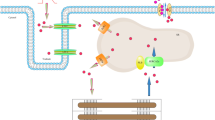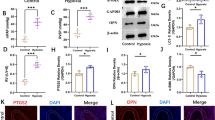Abstract
Myocardial ischemia can cause insufficient oxygen and functional damage to myocardial cells. Carbonic anhydrase III (CAIII) has been found to be closely related to the abnormality of cardiomyocytes. To investigate the role of CAIII in the apoptosis of myocytes under hypoxic conditions and facilitate the strategy for treating hypoxia-induced damage, in vitro experiments in H9c2 were employed. The protein expression of CAIII in H9c2 cells after hypoxia or normoxia treatment was determined by western blotting and immunohistochemistry. MTT assay was employed for cells viability measurement and LDH release was monitored. The apoptotic cells were observed using immunofluorescence assay, flow cytometric analysis, and TUNEL assay. CAIII-overexpression or -knockdown cells were constructed to determine the role of CAIII in regulating apoptosis-related proteins caspase-3, Bax, Bcl-2, and anti-apoptosis pathway PI3K/Akt/mTOR. The mRNA levels of CAIII and genes related to CAIII synthesis including REN, IGHM, APOBEC 3F, and SKOR2 were significantly upregulated in hypoxia fetal sheep. The expression of CAIII protein and content of apoptotic H9c2 cells were increased at 1, 3, 6, and 12 h after hypoxia treatment. Overexpression of CAIII significantly upregulated Bcl2 level and downregulated Bax and caspase-3 cleavage levels, while its knockdown led to the contrary results. Overexpressed CAIII promoted the HIF-1α level and activated the PI3K/Akt/mTOR pathway, thereby exerting an inhibitory effect on hypoxia-induced apoptosis. In conclusion, our findings revealed that CAIII could protect cell from hypoxia-apoptosis of H9c2 cells, in which, activated PI3K/Akt/mTOR signaling pathway may be involved.






Similar content being viewed by others
Data availability
All data generated or analyzed during this study are included in this manuscript.
Abbreviations
- CAIII:
-
Carbonic anhydrase III
- AMI:
-
Acute myocardial infarction
- MI:
-
Myocardial ischemia
- CA:
-
Carbonic anhydrase
- qRT-PCR:
-
Real-time reverse transcription quantitative PCR
- FBS:
-
Fetal bovine serum
- H/N:
-
Hypoxia/Normoxia
- DAPI:
-
4',6-Diamidino-2-phenylindole
- AV/PI:
-
Annexin V-FITC/propidium iodide
- DMSO:
-
Dimethyl sulfoxide
- LDH:
-
Lactate dehydrogenase
- SD:
-
Standard deviation
- ANOVA:
-
Analysis of variance
References
Gulati, R., Behfar, A., Narula, J., Kanwar, A., Lerman, A., Cooper, L., & Singh, M. (2020). Acute myocardial infarction in young individuals. Mayo Clinic Proceedings, 95, 136–156.
Li, M., Ding, W., Tariq, M. A., et al. (2018). A circular transcript of ncx1 gene mediates ischemic myocardial injury by targeting miR-133a-3p. Theranostics, 8, 5855–5869.
Han, D., Wang, Y., Chen, J., et al. (2019). Activation of melatonin receptor 2 but not melatonin receptor 1 mediates melatonin-conferred cardioprotection against myocardial ischemia/reperfusion injury. Journal of Pineal Research, 67, e12571.
Penaloza, D., & Arias-Stella, J. (2007). The heart and pulmonary circulation at high altitudes: Healthy highlanders and chronic mountain sickness. Circulation, 115, 1132–1146.
Wang, Y., Zhao, Z., Zhu, Z., Li, P., Li, X., Xue, X., Duo, J., & Ma, Y. (2018). Telomere elongation protects heart and lung tissue cells from fatal damage in rats exposed to severe hypoxia. Journal of Physiological Anthropology, 37, 5.
Innocenti, A., Scozzafava, A., Parkkila, S., Puccetti, L., De Simone, G., & Supuran, C. T. (2008). Investigations of the esterase, phosphatase, and sulfatase activities of the cytosolic mammalian carbonic anhydrase isoforms I, II, and XIII with 4-nitrophenyl esters as substrates. Bioorganic & Medicinal Chemistry Letters, 18, 2267–2271.
Zebral, Y. D., da Silva, F. J., Marques, J. A., & Bianchini, A. (2019). Carbonic anhydrase as a biomarker of global and local impacts: Insights from calcifying animals. International Journal of Molecular Sciences, 20, 3092.
Shang, X., Chen, S., Ren, H., Li, Y., & Huang, H. (2009). Carbonic anhydrase III: The new hope for the elimination of exercise-induced muscle fatigue. Medical Hypotheses, 72, 427–429.
Lippi, G., Schena, F., Montagnana, M., Salvagno, G. L., & Guidi, G. C. (2008). Influence of acute physical exercise on emerging muscular biomarkers. Clinical Chemistry and Laboratory Medicine, 46, 1313–1318.
Ren, H. M., Jiang-Long, T. U., Ai-Lian, D. U., & Huang, J. (2005). Demonstration of carbonic anhydrase III for 25 000 protein decreased in skeletal muscle of myasthenia gravis. Chinese Journal of Neurology, 38, 764–768.
Zoll, J., Ponsot, E., Dufour, S., et al. (2006). Exercise training in normobaric hypoxia in endurance runners. III. Muscular adjustments of selected gene transcripts. Journal of Applied Physiology, 100, 1258–1266.
Engelman, J. A. (2009). Targeting PI3K signalling in cancer: Opportunities, challenges and limitations. Nature Reviews Cancer, 9, 550–562.
Zhang, Y., Zhang, J. W., Lv, G. Y., Xie, S. L., & Wang, G. Y. (2012). Effects of STAT3 gene silencing and rapamycin on apoptosis in hepatocarcinoma cells. International Journal of Medical Sciences, 9, 216–224.
Jalde, F. C., Jalde, F., Sackey, P. V., et al. (2016). Neurally adjusted ventilatory assist feasibility during anaesthesia: A randomised crossover study of two anaesthetics in a large animal model. European Journal of Anaesthesiology, 33(4), 283–291.
Schill, M. R., Melby, S. J., Speltz, M., Breitbach, M., Schuessler, R. B., & Damiano, R. J., Jr. (2017). Evaluation of a novel cryoprobe for atrial ablation in a chronic ovine model. Annals of Thoracic Surgery, 104, 1069–1073.
Cicero, L., Fazzotta, S., Palumbo, V. D., et al. (2014). Anesthesia protocols in laboratory animals used for scientific purposes. Journal of the American Association for Laboratory Animal Science, 53(3), 290–300.
Fernando, S. C., Adriano, B. C., Alceu, G. R., et al. (2010). Total intravenous anesthesia with propofol and S(+)-ketamine in rabbits. Veterinary Anaesthesia and Analgesia, 37(2), 116–22.
Dileep, K., Gauhar, A., Muhammad, Z., et al. (2019). Isoflurane alone versus small dose propofol with isoflurane for removal of laryngeal mask airway in children-A randomized controlled trial. The Journal of the Pakistan Medical Association, 69(11), 1596–1600.
Tanya, D. N., Carolina, P. J., Tara, W., et al. (2015). Cardiopulmonary effects of dexmedetomidine and ketamine infusions with either propofol infusion or isoflurane for anesthesia in horses. Veterinary Anaesthesia and Analgesia, 42(1), 39–49.
Yang, J., Chen, L., Ding, J., et al. (2016). Cardioprotective effect of miRNA-22 on hypoxia/reoxygenation induced cardiomyocyte injury in neonatal rats. Gene, 579, 17–22.
Faridvand, Y., Nozari, S., et al. (2018). Nrf2 activation and down-regulation of HMGB1 and MyD88 expression by amnion membrane extracts in response to the hypoxia-induced injury in cardiac H9c2 cells. Biomedecine & Pharmacotherapie, 109, 360.
Li, H., Hu, J., Liu, Y., et al. (2018). Effects of prenatal hypoxia on fetal sheep heart development and proteomics analysis. International Journal of Clinical and Experimental Pathology, 11, 1909–1922.
Zhao, T., Fu, Y., Sun, H., & Liu, X. (2018). Ligustrazine suppresses neuron apoptosis via the Bax/Bcl-2 and caspase-3 pathway in PC12 cells and in rats with vascular dementia. IUBMB Life, 70, 60–70.
Yeung, H. M., Hung, M. W., Lau, C. F., & Fung, M. L. (2015). Cardioprotective effects of melatonin against myocardial injuries induced by chronic intermittent hypoxia in rats. Journal of Pineal Research, 58, 12–25.
Staunton, L., Zweyer, M., Swandulla, D., & Ohlendieck, K. (2012). Mass spectrometry-based proteomic analysis of middle-aged vs. aged vastus lateralis reveals increased levels of carbonic anhydrase isoform 3 in senescent human skeletal muscle. International Journal of Molecular Medicine, 30, 723–733.
Vaananen, H. K., Syrjala, H., Rahkila, P., et al. (1990). Serum carbonic anhydrase III and myoglobin concentrations in acute myocardial infarction. Clinical Chemistry, 36, 635–638.
Zhao, X., Wang, K., Hu, F., et al. (2015). MicroRNA-101 protects cardiac fibroblasts from hypoxia-induced apoptosis via inhibition of the TGF-beta signaling pathway. International Journal of Biochemistry & Cell Biology, 65, 155–164.
Lu, Z., Li, S., Zhao, S., & Fa, X. (2016). Upregulated miR-17 regulates hypoxia-mediated human pulmonary artery smooth muscle cell proliferation and apoptosis by targeting mitofusin 2. Medical Science Monitor, 22, 3301–3308.
Shang, X., Bao, Y., Chen, S., Ren, H., Huang, H., & Li, Y. (2012). Expression and purification of TAT-fused carbonic anhydrase III and its effect on C2C12 cell apoptosis induced by hypoxia/reoxygenation. Archives of Medical Science AMS, 4, 711–718.
Wu, X., Hao, C., Ling, M., Guo, C., & Ma, W. (2015). Hypoxia-induced apoptosis is blocked by adrenomedullin via upregulation of Bcl-2 in human osteosarcoma cells. Oncology Reports, 34, 787–794.
Pan, Y. L., Han, Z. Y., He, S. F., et al. (2018). miR133b5p contributes to hypoxic preconditioningmediated cardioprotection by inhibiting the activation of caspase8 and caspase-3 in cardiomyocytes. Molecular Medicine Reports, 17, 7097–7104.
Eldehna, W. M., Abo-Ashour, M. F., Nocentini, A., et al. (2017). Novel 4/3-((4-oxo-5-(2-oxoindolin-3-ylidene)thiazolidin-2-ylidene)amino) benzenesulfonamides: Synthesis, carbonic anhydrase inhibitory activity, anticancer activity and molecular modelling studies. European Journal of Medicinal Chemistry, 139, 250–262.
Saenz-de-Santa-Maria, I., Bernardo-Castineira, C., Secades, P., et al. (2017). Clinically relevant HIF-1alpha-dependent metabolic reprogramming in oropharyngeal squamous cell carcinomas includes coordinated activation of CAIX and the miR-210/ISCU signaling axis, but not MCT1 and MCT4 upregulation. Oncotarget, 8, 13730–13746.
Giacoppo, S., Bramanti, P., & Mazzon, E. (2017). Triggering of inflammasome by impaired autophagy in response to acute experimental Parkinson’s disease: Involvement of the PI3K/Akt/mTOR pathway. NeuroReport, 28, 996–1007.
LoPiccolo, J., Blumenthal, G. M., Bernstein, W. B., & Dennis, P. A. (2008). Targeting the PI3K/Akt/mTOR pathway: Effective combinations and clinical considerations. Drug Resistance Updates, 11, 32–50.
Shen, W., Cheng, K., Bao, Y., Zhou, S., & Yao, H. (2012). Expression of Glut-1, HIF-1α, PI3K and p-Akt in a case of ceruminous adenoma. Head & Neck Oncology, 4, 18.
Agani, F., & Jiang, B. H. (2013). Oxygen-independent regulation of HIF-1: Novel involvement of PI3K/AKT/mTOR pathway in cancer. Current Cancer Drug Targets, 13, 245–251.
Yang, L., Liu, Y., Wang, M., et al. (2016). Celastrus orbiculatus extract triggers apoptosis and autophagy via PI3K/Akt/mTOR inhibition in human colorectal cancer cells. Oncology Letters, 12, 3771–3778.
Kim, B. R., Shin, H. J., Kim, J. Y., Byun, H. J., Lee, J. H., Sung, Y. K., & Rho, S. B. (2012). Dickkopf-1 (DKK-1) interrupts FAK/PI3K/mTOR pathway by interaction of carbonic anhydrase IX (CA9) in tumorigenesis. Cellular Signalling, 24, 1406–1413.
Chu, Y. H., Su, C. W., Hsieh, Y. S., Chen, P. N., Lin, C. W., & Yang, S. F. (2020). Carbonic anhydrase III promotes cell migration and epithelial-mesenchymal transition in oral squamous cell carcinoma. Cells, 9, 704.
Dai, H. Y., Hong, C. C., Liang, S. C., Yan, M. D., Lai, G. M., Cheng, A. L., & Chuang, S. E. (2008). Carbonic anhydrase III promotes transformation and invasion capability in hepatoma cells through FAK signaling pathway. Molecular Carcinogenesis, 47, 956–963.
Funding
This research was supported by “The effects of hypoxia during pregnancy on fetal cardiovascular development and its related mechanisms” (Grant No.: 81560291).
Author information
Authors and Affiliations
Contributions
HL conceived and designed the entire study; HL and YBL collected and analyzed the data, and they were responsible for data interpretation; they were co-first authors; ST, JH, QLW, YW, and MN performed statistical analysis, literature research, and data visualization; HL and YBL wrote the manuscript. HL revised it critically for important intellectual content. All authors have read and approved the final manuscript.
Corresponding author
Ethics declarations
Conflict of interest
The authors declare that they have no competing interests.
Ethical approval
This study was approved by the Ethics Committee of General Hospital of Xinjiang Military Region of the People's Liberation Army (No. 2017.301).
Additional information
Handling Editor: Y. James Kang.
Publisher's Note
Springer Nature remains neutral with regard to jurisdictional claims in published maps and institutional affiliations.
Rights and permissions
About this article
Cite this article
Li, H., Liu, Y., Tang, S. et al. Carbonic Anhydrase III Attenuates Hypoxia-Induced Apoptosis and Activates PI3K/Akt/mTOR Pathway in H9c2 Cardiomyocyte Cell Line. Cardiovasc Toxicol 21, 914–926 (2021). https://doi.org/10.1007/s12012-021-09683-w
Received:
Accepted:
Published:
Issue Date:
DOI: https://doi.org/10.1007/s12012-021-09683-w




